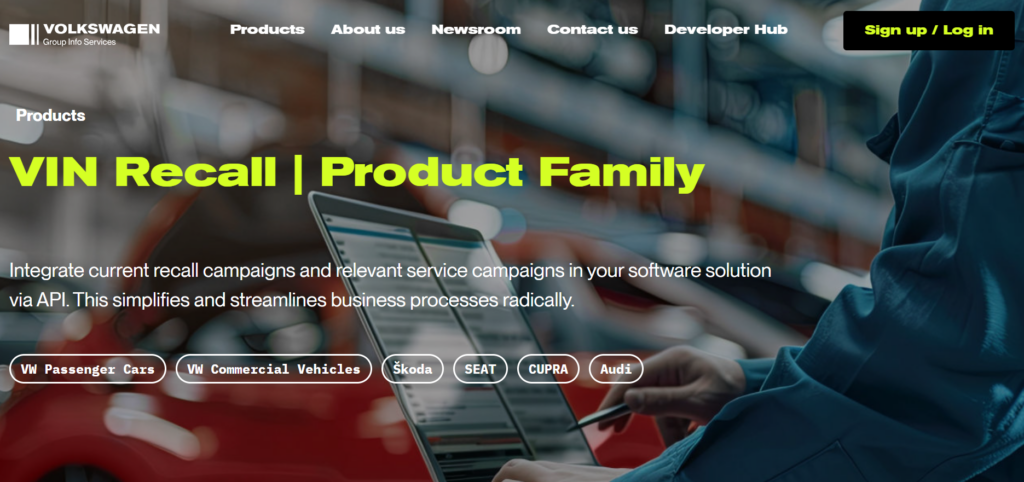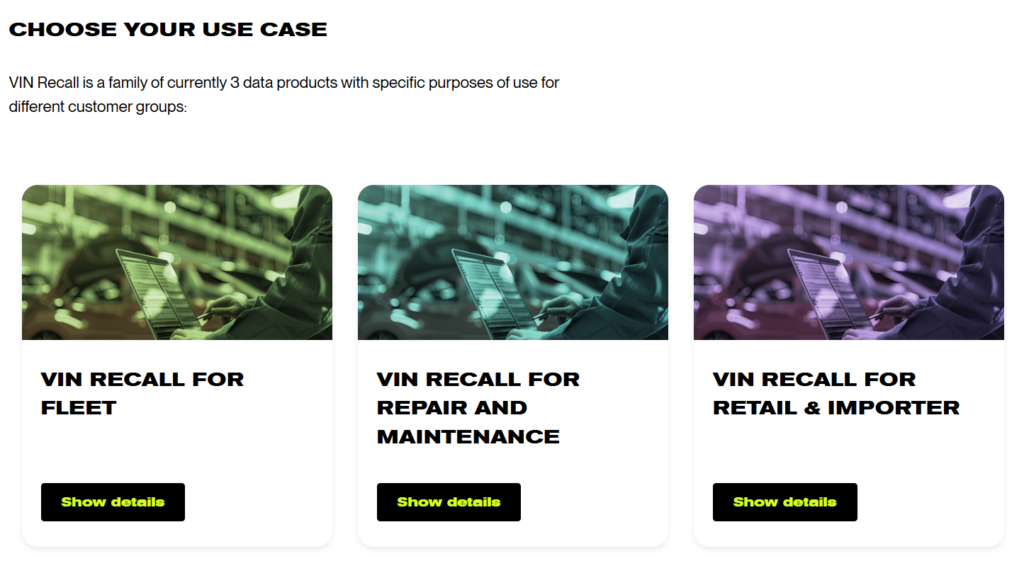Ensuring vehicle safety and operational efficiency are top priorities for businesses, from the car repair shop down the street to established car dealerships and fleet operators such as courier services. To improve these aspects, experts at diconium data developed several data products for a client. Find out what this project is about and how it works!
But before we look at the specific data products, we first need to start from the very beginning with the initial product: the individual vehicle and its VIN.
What Is a VIN?
Imagine the VIN as a car’s ID. The vehicle’s VIN, short for Vehicle Identification Number, is a universal identification based on an ISO standard, which makes it globally possible to identify a specific car and model.
How does the VIN look like?
A VIN could look like this: 1HGBH41JXMN109186
It contains 17 alphanumeric characters, which provide information about the vehicle. The first three characters make up the World Manufacturer Identifier (WMI) and tell who the automaker was and in which country the car was produced. The next six characters, the Vehicle Descriptor Section (VDS), contain more detailed information about the car model. The last eight characters, called the Vehicle Identifier Section (VIS), deliver the remaining missing data: the production year and location as well as the vehicle’s serial number.
Where to find the VIN
The location of the VIN depends on the car. Often, you can find it on the driver’s dashboard, making it readable while looking through the front window. Sometimes, it’s like a sticker on the side door or in the engine area. You should always find the VIN in the car insurance card and documents too.
Why does the VIN exist?
The VIN is a useful tool for tracking vehicle histories. This can be very practical when you want to buy a used car and check if the provided information is correct. Also, insurance companies use the VIN to determine accurate vehicle data. But there are more cases in which the VIN can be quite helpful – repairs and recalls, for example. Workshops can easily order suitable replacement parts if necessary and have access to specific repair instructions based on the VIN. Vehicle owners and distributors can find out if their car is involved in a safety recall and are able to make further decisions based on this information. The topic of vehicle recall has been playing a role recently at diconium data, particularly in a new customer project for the Volkswagen Group.
Proactive Vehicle Safety – the Importance of Recalls
The automotive industry is highly complex, and even with rigorous quality control, occasional issues can arise. For the Volkswagen Group, vehicle safety is a top priority. That’s why they invest in a supportive and transparent recall system. Great and helpful customer service is based on responsibility, transparency, and continuous improvement. With millions of cars manufactured, it would be unrealistic to claim that every single one is always perfect. How well this challenge is managed sets a responsible brand apart. A responsible brand takes proactive measures to identify vehicles that require attention and ensures that customers receive the highest level of safety and service.
Through structured recall processes and advanced digital solutions like our VIN Recall Product Family, the Volkswagen Group ensures that necessary updates or repairs are efficiently communicated and addressed. This commitment helps maintain vehicle value, enhances safety, and strengthens customer trust. Recalls are not about just fixing some issues – they ensure that every vehicle on the road meets the highest standards. Not just at the time of sale but throughout its entire lifecycle.

Our New Data Product Family: VIN Recall
The VIN Recall Product Family for the Volkswagen Group is a suite of three data products designed to simplify and streamline recall and service campaign processes for various customer groups. These products provide digital access to data from current recalls and relevant service campaigns for Volkswagen’s brands, supporting vehicles from Volkswagen Passenger Cars, Volkswagen Commercial Vehicles, Skoda, SEAT, CUPRA, and Audi, enabling seamless integration into software systems via API. Intended for companies owning vehicle fleets or involved in the automotive sales and service industry, these data products are exclusively for B2B use.

VIN Recall for Fleet
Fleet, in this context, refers to a collection of vehicles owned or leased by a business or organization. This product helps fleet management and remarketing processes by providing VIN-based information on recalls, allowing for quick checks and repairs of vehicles in a fleet. Previously, the checking was carried out manually, so the digital VIN Recall for Fleet supports fleet operators in ensuring vehicle and legal safety with improved efficiency and reduced manual errors during vehicle procurement and remarketing.
A practical example
A food delivery service operates a fleet of 1000 vehicles, comprising different models from Volkswagen Passenger Cars, Audi, and SEAT. The company often faces challenges in manually tracking vehicle recalls, leading to overlooked recalls, posing safety risks, and potential legal issues. By integrating the VIN Recall for Fleet API into its Fleet Management Software, the company revolutionizes its recall management process and improves operational efficiency.
VIN Recall for Repair & Maintenance
Designed for both independent and authorized workshops as well as companies involved in vehicle repair, this product delivers fast, reliable recall information. Integrating VIN Recall for Repair & Maintenance via API in the used software solution streamlines repair processes and enhances customer service and satisfaction.
A practical example
A large and well-booked car repair shop invests much time and effort in planning repair appointments since they do not have enough employees currently. Managing and integrating recall-related repairs with regular maintenance appointments is one of the shop’s biggest challenges, often leading to scheduling conflicts and customer dissatisfaction. Integrating the VIN Recall for Repair & Maintenance helps them streamline operations. When customers book appointments, VIN Recall checks their vehicles for outstanding recalls, allowing the shop to incorporate necessary repairs into their schedule. This ensures efficient resource allocation and reduces customer wait times, enhancing overall service capacity. Customers are notified in advance about recall repairs, leading to transparent, convenient service experiences and an optimized workflow.
VIN Recall for Retail & Importer
Integrated into the car dealers’ and importers’ Dealer Management Software (DMS), this tool supports managing recalls during sales processes. It provides legal compliance in sales transactions by ensuring that recalls are addressed.
A practical example
Because of somepost-sale recall surprises, a car dealer had to face some dissatisfied customers recently. Now, she uses the VIN Recall for Retail & Importer API to check each VIN for active recalls, addressing them promptly to ensure that vehicles are sold without pending issues. Since she does this, new customers trust her business even more and will keep their freshly bought cars. Also, they appreciate the transparency about potential resolved recalls.

And How Did the Team Experience this Project?
What was new about working on this product?
“The VIN Recall product is a microservice, which means that instead of
creating one large product, the standard is now to split it into small services,
small autonomous units.”
What were your biggest challenges to overcome?
“We had to connect to a legacy product, which was a challenge
because the protocol used – SOAP – was quite outdated, so we needed to
build up our knowledge to master that challenge.”
Any technology you can share without giving away our product secrets?
“We used Java, Spring Boot, SOAP, Karate testing, Scala, Terraform
(our infrastructure-as-code), GitHub Actions workflows, ArgoCD, and Swagger.”
What were the main steps in developing this product?
“We started with setting up the environment.
After that we connected to the data source by using SOAP protocol.
Then, we implemented various measures to ensure everything was working properly, including multiple types of testing, such as unit tests (with more than 85% coverage), integration tests, end-to-end (E2E) testing, performance tests, and manual testing.”
What made you excited about developing this product?
“We are excited to think about the future because with each product, we realize how many possibilities exist for developing more data products and using data creatively.”
“We had great teamwork!”
“We were impressed with how quickly we developed the product using knowledge
that we have gained over the past when developing other products.”

